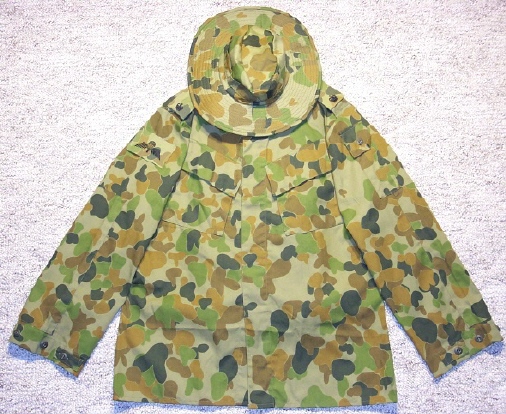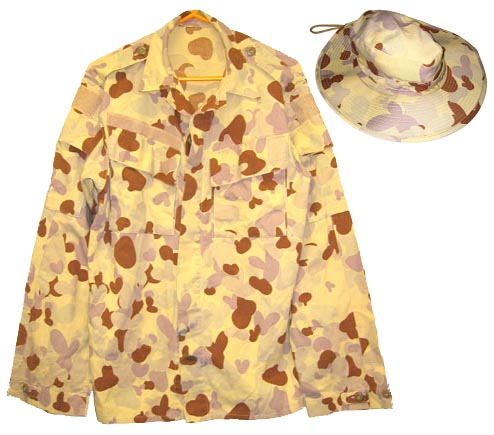Australian Army
From Daily Escape
The Australian Army is Australia's military land force. It is part of the Australian Defence Force (ADF) along with the Royal Australian Navy and the Royal Australian Air Force. The Army is commanded by the Chief of the General Staff (CGS), who is responsible to the Chief of the Defence Force Staff (CDS). The current Chief of the General Staff is Lieutenant General P.F. Leahy, AC.
Australian soldiers have been involved in a number of minor and major conflicts throughout its history, but only in World War II did Australian territory come under direct attack.

Australian Army Rising Sun badge
Contents |
Mission
Australian Government websites state that the Army's mission is to provide a potent, versatile and modern Army to promote the security of Australia and protect its people and interests. Further, the Army's key doctrine publication, The Fundamentals of Land Warfare, states that "the Army’s mission is to win the land battle".
Organsation
The Australian Army consists of a number of Brigades, each of which has different roles. The Brigades are based around Infantry Battalions. Elements from other units, (or the entire units themselves) are attached as required to form Brigade battle groups, or Battalion battle groups
- 1 Brigade (Mechanised infantry, equipped with CV90A and ASLAV)
- 5th Battalion, Royal Australian Regiment
- 7th Battalion, Royal Australian Regiment
- 1st Battalion, Royal New Zealand Infantry Regiment
- 2 Brigade (Motorised Infantry, equipped with M113, and ASLAV)
- 6th Battalion, Royal Australian Regiment
- 8th Battalion, Royal Australian Regiment
- 9th Battalion, Royal Australian Regiment
- 3 Brigade (Light Infantry, equipped with Bushmaster IMV, and ASLAV)
- 1st Battalion, Royal Australian Regiment
- 2nd Battalion, Royal Australian Regiment
- 1st Battalion, Royal Pacific Islands Regiment
- 1st Battalion, Fiji Infantry Regiment (Airborne)
- 3rd Battalion, Royal Australian Regiment (Airborne)
- 1st Armoured Regiment, Armoured Regiment
- 2nd/4th Armoured Regiment, Armoured Regiment
- 2/8th Armoured Regiment (Light), Light Armoured Regiment, equipped with M8 Buford
- 2nd Cavalry Regiment, Formation Reconnaissance Regiment
- 3rd/4th Cavalry Regiment, Formation Reconnaissance Regiment
- 2nd/14th Light Horse Regiment, Formation Reconnaissance Regiment
- 16 (Aviation) Brigade
- 1st Aviation Regiment, Attack helicopter Regiment
- 5th Aviation Regiment (transport helicopter)
- 173rd Surveillance Squadron (light aircraft)
- Aviation Support Group Workshop
There are also reserve infantry, armoured, and cavalry formations.
Special Forces
Special Forces are controlled by Australian Special Operations Command
- Australian Special Service Regiment
- 4th Battalion, Royal Australian Regiment
- 1st Commando Regiment (Australia)
- 171st Aviation Squadron (Australia)
- Incident Response Regiment
- Special response unit for nuclear, biological, chemical and radiological hazards, and explosive hazards.
Regional Force Surveillance Units
The Regional Force Surveillance Units (RFSUs) are specialised units of the Australian Army responsible for patrolling northern Australia. The RFSUs regularly conduct operational patrols during peacetime, and the reservists who make up 90% of the RFSUs personnel carry out most of their training during these patrols.
- North-West Mobile Force (NORFORCE) (responsible for the Northern Territory and Kimberley region of Western Australia)
- The Pilbara Regiment (responsible for the Pilbara region of Western Australia)
- 51st Battalion, Far North Queensland Regiment (responsible for North Queensland)
Equipment
Small Arms
- L9A1 Browning Hi-Power Pistol
- Heckler und Koch USP Pistol (Special Forces)
- F88 Austeyr Rifle
- M4A5 Carbine (Special Forces)
- Heckler und Koch MP5 Submachine Gun (Special Forces)
- F89 Minimi Light Machine Gun
- MAG 58 General Purpose Machine Gun
- M2 QCHB Heavy Machine Gun
- Remington 870 Shotgun
- M203-PI Grenade Launcher
- Mk 19 Automatic Grenade Launcher
- SR-98 Sniper Rifle
- AW50F Anti-Material Rifle
- 66 mm Short-Range Anti-Armour Weapon
- 84mm Carl Gustav Medium Range Anti-Armour Weapon (MRAAW)
- FGM-148 Javelin
Artillery
- F1 81mm Mortar
- L118 Hamel 105mm Light Gun
- M2A2 105mm howitzer (Reserve)
- M198 155mm howitzer
Air Defence
- FIM-92 Stinger
- RBS-70
- MIM-163 Scimitar
- MIM-120 AMRAAM
Armoured Vehicles
- M1A1 Abrams Main Battle Tank
- M104 Wolverine Heavy Assault Bridge
- M1 Grizzly Engineer Vehicle
- M88A2 Hercules Armoured Recovery Vehicle
- CV90A (CV90 modified for Australian conditions, including ADF standard communications equipment, and environmental systems for Australian conditions, drinking water cooling and storage)
- CV9040A Original version, upgraded with twin TOW launchers
- CV9035A AAV (Turret system with 2 35mm cannon, and 8 ACLOS/IR guided missiles, Battalion level air defence)
- CV90A-FOV Forward Observation Vehicle
- CV90A-R Armored Recovery Vehicle
- M113A4 MTVL
- M113A4 Recovery Vehicle
- M113A4 Cargo Vehicle
- M727A4 HAWK-AMRAAM Launcher
- M8 Buford
- ASLAV
- ASLAV-25 (Reconnaissance)
- ASLAV-S (Surveillance)
- ASLAV-F (Fitter)
- ASLAV-R (Recovery)
- ASLAV-A (Ambulance)
- ASLAV-PC (Personnel Carrier)
- ASLAV-AT (Anti-Tank)
- ASLAV-AD (Air Defence)
- ASLAV-M (120mm Mortar Carrier)
- Bushmaster IMV
Aircraft
- S-70A Blackhawk
- CH-47D Chinook
- OH-58A Kiowa
- Tiger ARH
- Beech King Air
Future Equipment Requirements
The Australian Army is currently examining options for new Artillery systems, both towed and self-propelled.
Combat Uniforms
The Australian Army (along with the Royal Australian Navy, and Royal Australian Air Force wear a distinctive camouflage uniform designed for the Australian environment.
Disruptive Pattern Camouflage Uniform

Disruptive Pattern Camouflage Uniform, suitable for any non-desert environment.
Disruptive Pattern Desert Uniform

Disruptive Pattern Desert Uniform, suitable for any desert environment.





